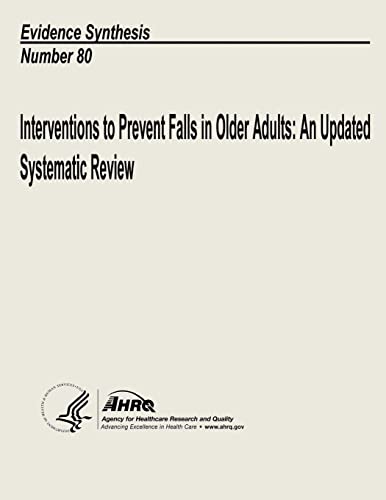Verwandte Artikel zu Interventions to Prevent Falls in Older Adults: An...
Interventions to Prevent Falls in Older Adults: An Updated Systematic Review: Evidence Synthesis Number 80 - Softcover

Zu dieser ISBN ist aktuell kein Angebot verfügbar.
Alle Exemplare der Ausgabe mit dieser ISBN anzeigen:
Reseña del editor:
This review was undertaken to support the U.S Preventive Services Task Force (USPSTF) in updating its 1996 recommendation on prevention of falls in older adults, which was part of its general review on household and recreational injuries. The 1996 USPSTF review found sufficient evidence that certain interventions reduce the risk for falls. This review found insufficient evidence, however, that counseling could be generalized to the primary care setting or that counseling reduced fall risk factors or the incidence of falls. The USPSTF also found insufficient evidence to recommend for or against the routine use of external hip protectors to prevent fall injuries. Issues requiring rectification for the USPSTF to change its recommendations include evidence showing that: primary care feasible interventions reduce the risk for falls or fall-related injuries in high-risk older adults; the general population benefits from these interventions; primary care counseling reduces the incidence of falling or fall-related injuries; primary care counseling is effective in encouraging older adults to increase their physical activity levels; and screening (balance and gait, visual acuity, ophthalmoscopic exam, dementia or altered mental status) reduces incidence of falls or fall-related injuries. A fall is “an unexpected event in which the participant comes to rest on the ground, floor, or lower level.” Because no single definition for a fall was consistently used across studies, we use the definition of a fall used by each reviewed study to maximize the number of included studies in the current review. People aged 65 years and older represent the fastest-growing segment of the U.S. population. Falls are associated with many adverse health outcomes, including injury and death. In 2003, the Centers for Disease Control and Prevention reported that falls were the leading cause of injury deaths, and the ninth leading cause of death from all causes, among those 65 years of age and older. Falls and fall-related injuries increase with age. Hip fractures are an especially grave complication of falls in older adults, resulting in more hospital admissions than any other injury. There is a 10% to 20% reduction in expected survival during the first year following a hip fracture, and roughly half of the survivors never recover normal function. Falls also predict quality of life and disability. Twenty to 30% of those who fall suffer injuries that result in decreased mobility that limits subsequent independence. Even falls that do not result in injury can lead to negative outcomes. In particular, experiencing a fall can increase an older person’s fear of falling, an important psychological outcome correlated with future falls. Fear of falling leads older adults with and without a history of falling to limit activities, which eventually increases fall risk through functional decline, deterioration in perceived health status, and increased risk for admission to institutional care. KQ 1: Is there direct evidence that primary care interventions reduce fall-related injury, improve quality of life, reduce disability, or reduce mortality when used alone or in combination to reduce falling in community-dwelling older adults? 1a. Do these interventions reduce injury, improve quality of life, reduce disability, or reduce mortality in older adults specifically identified as high risk for falls? KQ 2: Do primary care interventions used alone or in combination in community-dwelling older adults prevent falling? 2a. Do these interventions prevent falling in older adults specifically identified as high risk for falls? 2b. Are there positive outcomes other than reduced falling, and related morbidity and mortality, that result from primary care interventions to prevent falling? KQ 3: What are the adverse effects associated with interventions to prevent falling? KQ 4: How are high-risk older adults identified for primary care interventions to prevent falling?
„Über diesen Titel“ kann sich auf eine andere Ausgabe dieses Titels beziehen.
- VerlagCreateSpace Independent Publishing Platform
- Erscheinungsdatum2013
- ISBN 10 1484950518
- ISBN 13 9781484950517
- EinbandTapa blanda
- Anzahl der Seiten400
Gebraucht kaufen
Zustand: Sehr gutZustand: Sehr gut - Gepflegter,... Mehr zu diesem Angebot erfahren
EUR 18,88
Versand:
EUR 45,00
Von Deutschland nach USA
Beste Suchergebnisse beim ZVAB
Interventions to Prevent Falls in Older Adults: An Updated Systematic Review: Evidence Synthesis Number 80
Verlag:
CreateSpace Independent Publishing Platform
(2013)
ISBN 10: 1484950518
ISBN 13: 9781484950517
Gebraucht
Softcover
Anzahl: 1
Anbieter:
Bewertung
Buchbeschreibung Zustand: Sehr gut. Zustand: Sehr gut - Gepflegter, sauberer Zustand. | Seiten: 400. Artikel-Nr. 37503888/2
Weitere Informationen zu diesem Verkäufer | Verkäufer kontaktieren
Gebraucht kaufen
EUR 18,88
Währung umrechnen

